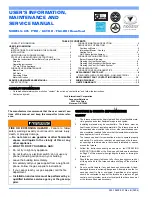
HIGH TEMPERATURE
FURNACE HANDBOOK
ISSUE 8 - 05/05
Page 26 of 37
end of the Scale. The defining point applicable to long stem thermometers at the low end of
their useful range is the triple point of argon. In practice, the difficulties of setting up
conditions to facilitate this measurement can conveniently be circumvented by carrying out
the alternative procedure of comparison calibration, in which the thermometer is compared,
in an environment of boiling nitrogen, to a similar thermometer which possesses a calibration
traceable to national standards. A separate manual describes the nitrogen boiling point
apparatus.
The temperature at which the change of phase occurs at atmospheric pressure is specific to
the upper, exposed, surface of the metal. However, it is not feasible (because of the
temperature gradient in this locality of the thermometer well) to obtain an accurate
measurement under this condition. The closest approach to temperature uniformity
demands insertion of the thermometer to the foot of the well with the consequence that the
change-of-phase temperature measured is influenced by the static pressure head of the
column of metal above the effective level of the thermometer sensing element.
Corrections that are used to enable measured phase-change temperatures to be converted
to values that would pertain at 1 standard atmosphere pressure, for the various metals (and
for mercury and water at their triple points), are given in the table on page 28. For a given
column height (of the order of 200mm for Isotech sealed freeze point cells), the correction
will be proportional to metal density and to a coefficient expressing the sensitivity to pressure
of the phase-change temperature. The sign of this coefficient will depend on whether the
metal contracts or expands on freezing.












































